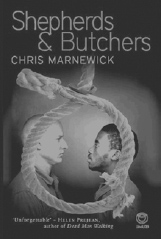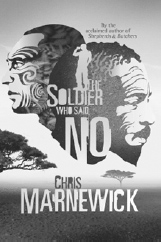A Sailor's Honour (34 page)

Whilst this paper is not at liberty to disclose their names at this stage, it can confirm that they were members of the Civil Cooperation Bureau, which was engaged in a campaign of dirty tricks before the 1994 transition to democracy.
A spokesman for the workers expressed concern about salaries now that the farm operations have been closed down by the authorities.
Durban
Wednesday, 7 July 2010
Hop. Skip. Jump.
Hop. Skip. Jump.
Zoë de Villiers held onto the hands of the adults on either side of her and skipped to the dictates of the lines on the pavement of the street outside the Moses Mabhida Stadium. Walter Gilbert Road had been converted to a pedestrian mall and the brick paving made a perfect hop-skip-and-jump grid for a little girl with a good imagination.
âCome on, Zoë,' her mother admonished her. âDon't hang onto Auntie Liesl's arm like that. You'll hurt her.'
âDon't worry about me, Emma,' Liesl Weber said. âI can't wait to have a grandchild.'
Behind the women, Pierre de Villiers and Johann Weber had stopped to take photographs.
âThis is one hell of a stadium,' Pierre de Villiers said. âWhen I was here a year ago, it was all cranes and cement trucks and security checkpoints and men in hard hats. Now look at it.' He swung his camera in an arc from left to right to take a sequence of photographs that could be laid together to create a single landscape. The stadium was too big to fit into his camera's viewfinder.
They had decided to come to the stadium early to be sure of finding parking and having the opportunity to experience the vibe of the World Cup semifinal. Contrary to their expectations, the traffic between the Webers' Durban North home and the stadium had been smooth and the drive without incident. The car was parked in a side street above Umgeni Road under the watchful eyes of a car guard who spoke English with a French accent. From the time they had alighted from the car, the stadium had dominated the view. It stood like a giant illuminated vanilla cheesecake in a sea of dark chocolate.
There were flags and vuvuzelas everywhere and the noise was earsplitting. German and Spanish mementos were on sale everywhere. One man offered earplugs and was doing a brisk trade.
The Webers were of German ancestry and were naturally aligned to the German team. De Villiers, on the other hand, was of French extraction, and tended to side with the Latin nations, although most of them had been a grave disappointment thus far in the competition. The African sides had not performed well either, but De Villiers no longer felt African. He was pleased to note that New Zealand was the only side in the competition not to have lost a game. But even that was little consolation; they had already returned home.
Zoë bumped into her father as she waved a German flag. De Villiers studied a brochure that accompanied the batch of items handed to all spectators at the gate. There was a photograph of the stadium on the cover far better than any De Villiers could take with his camera.
The arch is one of the most spectacular aspects of the multi-billion-rand stadium construction. The first sections of the free-span arch arrived from Hamburg, Germany, little over a year earlier.
The mood of the place was almost eerie. It was well past the hour when Durbanites would usually lock themselves behind their doors and security systems, yet here they mingled in large numbers in the artificial light of a thousand street lights.
The stadium dominated everything. Like the believers descending upon the mountain in
Close Encounters of the Third Kind
, everyone appeared to react to its irresistible pull. The Weber party slowly made their way towards the southern side and around to an entrance near their seats in the middle, expensive section, almost on the centre line.
âHello, Judge,' someone said behind them.
De Villiers watched as Johann Weber turned and spoke to the man in the row behind them.
âSo you're a judge now?' De Villiers asked when Weber sat down again.
Johann Weber shrugged. âIt's just an acting appointment. It's dirty work, but someone's got to do it.'
On the field, the dirty work was being done by the midfielders. Both teams played like men afraid of losing and, consequently, too afraid to venture forward. The ball was passed from man to man in the midfield, from side to side in that section of the field directly under De Villiers's eyes.
Johann Weber tried to explain the rules and tactics to his wife, who showed interest only in Zoë's antics. Bored, De Villiers studied the arch from below. In the light, he could see the steel cables stretch from the roof to the arch and he wondered how the cables were attached to the reinforced concrete of the arch.
At half time Zoë sang and sashayed with the street children on the big screen until a cacophony of vuvuzelas made it impossible to hear the words of the official song of the competition.
When the teams came out for the second half, one player got up and brought the game to life. Xabi Alonso dazzled the German defenders and the crowd with deft touches and turns and crisp passes. It was inevitable that the Germans would concede a corner too many, and when Carles Puyol dashed forward unmarked to rise above the defenders and head the ball past the wrong-footed goalkeeper, the game was effectively over.
In the stands, sixty-two thousand spectators watched the game with varying degrees of appreciation. Around them the hundred-and-two outer columns stood proud, buried deep in the African soil. A steel cable was tied to the top of each column by a special mechanism. Each cable led to the arch where a similar mechanism tied it to the arch. The steel cables were made of local materials and supported the diaphanous Teflon roof membrane through which the light below reached up into the sky.
Above the heads of the crowd, the arch held everything together in a whole which was greater than the sum of its individual parts.
It was a good night.
During the long flight back to New Zealand, Zoë sang in tune but the words were scrambled.
Wakey wakey! Good soldier
Wakey wakey! You're a good soldier
Not anymore, De Villiers thought. He shook his head. Not anymore.
Operation Weissdorn and Robey Leibbrandt's part in it is fully chronicled in
For Volk and Führer
by Hans Strydom, published in 1982 by Jonathan Ball Publishers. I cheated a little with the facts. Leibbrandt came here on a yacht, as Strydom wrote, not by
U
-boat, although that was the rumour the Third Force spread at the time.
Hitler did give an order that his submarine crews were to destroy enemy lifeboats and crews after his
U
-boats had sunk their vessels. Except for one isolated incident, which took place before his order, no submarine crew ever carried out Hitler's order. Grand-Admiral Karl Dönitz was nevertheless convicted at the conclusion of the main Nuremberg War Crimes Trial of crimes against the peace (for training the German Navy) and of war crimes (for not countermanding Hitler's order). He was sentenced to ten years imprisonment.
U-Boats to the Rescue: The Laconia Incident
by Léonce Peillard, translated by Oliver Coburn and published by Jonathan Cape in 1963, gives a studied account of the sinking of the passenger ship
Laconia
and the valiant efforts of the crews of several
U
-boats to save the survivors, even when bombed by an American Liberator aircraft while they were towing strings of lifeboats with survivors.
Kapitänleutnant Karl-Heinz Weber is a fictitious character.
U
-boat 891 was never commissioned and never participated in the rescue, but otherwise the facts of the
Laconia
incident have been stated as accurately as my research allowed.
As for the existence and activities of the Third Force, they are fig-ments of my imagination. As with the
Laconia
affair, I should like to think that there would be a fair measure of correspondence with the truth that lies below the surface of the recorded history of this country. The evil that was perpetrated by the various actors in the liberation struggle â on both sides â is beyond anything an author's imagination could produce. The assassination of Verwoerd, the suppression of a medical paper suggesting that a deadly virus was entering the country via its transport routes, the
Alicia Mae
affair: all of these may well have one leg standing firmly on the truth, but I have used those events in a strictly fictitious setting.
The places are real; the people who dwell there are not.
There is a swastika in the sandstone of the Soutpansberg near the remains of the hut where Robey Leibbrandt hid from the police all those years ago.
As for the
Alicia Mae
: I believe there is no record of her anywhere.
But there was a lion called Bosveld, and he was the biggest lion ever held in captivity.
Everyone knows that, don't they?
Shepherds & Butchers
Chris Marnewick

âPossibly the most gripping, most gruelling novel I've read'
VIVIEN HORLER
,
CAPE ARGUS
Leon Labuschagne's livelihood depends on death. At nineteen, he is a Death Row warder at Maximum Security Prison in Pretoria: a shepherd who cares for the condemned â and a butcher who escorts them to the gallows. In the summer of 1987, after thirty-two men were hanged in two weeks (all real cases), Leon loses control, with tragic results. And now he's the one facing the death penalty (fiction).
Only the most precarious line of legal argument stands between Leon and the gallows. Chasing a defence, his advocate trawls the deepest recesses of life in the Pot â the twilight world of Death Row â in order to determine the effect of multiple executions on his young client.
In 1987, 164 people were executed at Maximum Security. Two years later, the last man went to the gallows, after more than four thousand hangings in Pretoria in that century.
Shepherds & Butchers
portrays legal execution in unprecedented detail, revealing its devastating impact on all those involved. At the same time, it exposes the callous violence on the other side of the noose, where murderers reign. Chris Marnewick's first novel is a gripping courtroom drama steeped in the factual.
ISBN
: 978-1-4152-0044-5 (print)
ISBN
: 978-1-4152-0327-9 (e-
PUB
)
ISBN
: 978-1-4152-0328-6 (
PDF
)
Novel | May 2008
Fiction; 231
x
152 mm;
Trade paperback; 416 pages;
Recommended retail price
R
180
Chris Marnewick

â
The Soldier who said No
is a slick thriller'
MARGARET VON
KLEMPERER
,
THE WITNESS
New Zealand was supposed to be where Pierre de Villiers would escape his past. A misadventure in Angola had cost him his faith in the military, and almost his life and sanity. Another event cost him his family.
But no. After a bizarre attempt on the NZ Prime Minister's life De Villiers recognises the arrow used: it is of Bushman origin. And suddenly he, now a policeman in Auckland, is a suspect.
He must go back to South Africa for answers, and to face his demons. Can he unscramble his memory? Will he find the men who devastated his life? And will the illness mounting in his groin be cured?
The Soldier Who Said No
is about a man cast adrift in a sea of impossible choices. It is a gripping thriller set in a complex world of racism in unexpected places, and old injustices festering on both sides of a vast ocean.
ISBN
: 978-1-4152-0108-4 (print)
ISBN
: 978-1-4152-0333-0 (e-
PUB
)
ISBN
: 978-1-4152-0334-7 (
PDF
)
